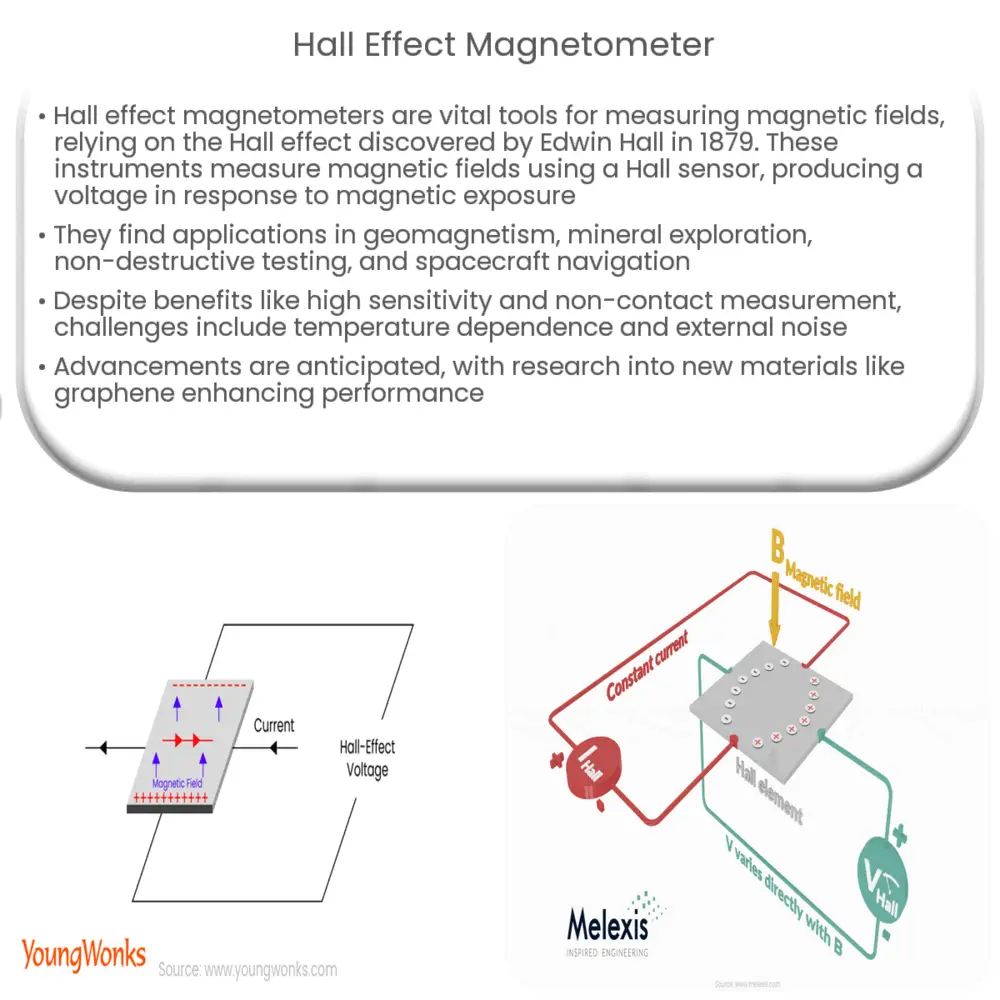Hall effect magnetometers measure magnetic fields using the Hall effect principle, offering high sensitivity, accuracy, and a wide range of applications.

Hall Effect Magnetometer: A Comprehensive Overview
When it comes to the study and measurement of magnetic fields, Hall effect magnetometers have emerged as a prominent and reliable tool. This article delves into the principles and applications of Hall effect magnetometers and how they contribute to advancements in various fields. We will begin by understanding the Hall effect and the basics of a Hall effect magnetometer, before exploring their practical applications and future prospects.
Understanding the Hall Effect
The Hall effect is a phenomenon discovered by Edwin Hall in 1879. It refers to the production of a voltage difference (Hall voltage) across an electrical conductor when subjected to a magnetic field perpendicular to the direction of the electric current flowing through the conductor. The magnitude of the Hall voltage is proportional to the product of the magnetic field and the current, and inversely proportional to the charge carrier density in the material. The Hall effect has proved to be a fundamental principle in various scientific and engineering domains, including magnetometry.
Basics of Hall Effect Magnetometers
Hall effect magnetometers are instruments that leverage the Hall effect to measure magnetic fields. They consist of a thin, flat semiconductor material, referred to as the Hall sensor or Hall probe, through which a constant current is passed. When the Hall sensor is exposed to a magnetic field, it generates a Hall voltage, which is measured and used to determine the magnetic field strength.
There are two main types of Hall effect magnetometers: linear and threshold. Linear magnetometers provide a continuous output voltage proportional to the magnetic field, while threshold magnetometers produce an output signal only when the magnetic field surpasses a predetermined threshold value. Each type has its own advantages and applications, depending on the desired accuracy and sensitivity.
Key Components and Materials
A typical Hall effect magnetometer includes three primary components: the Hall sensor, a signal conditioning circuit, and a readout or display device. The Hall sensor is the most critical component, as it directly interacts with the magnetic field and generates the Hall voltage. It can be made from various semiconductor materials, such as silicon, germanium, or gallium arsenide, each with its own characteristics and performance parameters.
The signal conditioning circuit amplifies and filters the Hall voltage, preparing it for interpretation by the readout device. This circuit may include operational amplifiers, voltage regulators, and other electronic components to ensure the output signal’s accuracy and stability. The readout device can range from a simple voltmeter to sophisticated digital displays or data acquisition systems, depending on the application’s requirements.
Applications of Hall Effect Magnetometers
Hall effect magnetometers have found widespread use in various industries and research fields due to their versatility, accuracy, and non-invasive nature. Some common applications include:
- Geomagnetism studies and Earth’s magnetic field mapping
- Magnetic anomaly detection for mineral exploration
- Non-destructive testing and quality control of ferromagnetic materials
- Spacecraft attitude control and navigation systems
Advantages of Hall Effect Magnetometers
Hall effect magnetometers offer several benefits that have contributed to their popularity in various fields:
- High sensitivity and accuracy: These magnetometers can detect and measure extremely weak magnetic fields with high precision, making them suitable for a wide range of applications.
- Wide dynamic range: They can measure magnetic fields over a broad range of magnitudes, from nanoteslas (nT) to several teslas (T).
- Fast response time: Hall effect magnetometers provide real-time measurement and rapid response to changes in the magnetic field, making them ideal for dynamic environments and time-sensitive applications.
- Non-contact measurement: Since the Hall sensor does not need to physically touch the magnetic source, it allows for non-invasive and non-destructive testing.
- Compact and robust: These devices are generally small and lightweight, with few moving parts, ensuring reliability and durability in various operating conditions.
Challenges and Limitations
Despite their numerous advantages, Hall effect magnetometers also have certain limitations:
- Temperature dependence: The performance of a Hall effect magnetometer can be affected by temperature variations, leading to changes in the sensor’s sensitivity and offset. This issue can be addressed through temperature compensation techniques, such as using a temperature sensor in conjunction with the Hall sensor.
- External noise: Electromagnetic interference and noise from nearby electronic devices can impact the accuracy of the Hall voltage measurement. Proper shielding, filtering, and grounding techniques are essential to minimize these effects.
- Saturation effects: When exposed to extremely strong magnetic fields, the Hall sensor can saturate, causing non-linear response and reduced measurement accuracy. This limitation can be mitigated by selecting sensors with higher saturation levels or by using magnetic shielding.
Future Prospects
As technology continues to advance, the development of Hall effect magnetometers is expected to yield even greater performance improvements and novel applications. Researchers are exploring new materials, such as graphene and other two-dimensional materials, which exhibit exceptional properties that could lead to ultra-sensitive and miniaturized Hall sensors. Furthermore, advancements in signal processing and data analysis techniques are expected to enhance the accuracy and versatility of these devices.
Conclusion
Hall effect magnetometers have emerged as a crucial tool in the measurement and analysis of magnetic fields. With their high sensitivity, accuracy, and wide range of applications, these instruments have become indispensable in various scientific, industrial, and aerospace contexts. As research and development efforts continue to expand the boundaries of what is possible with Hall effect magnetometers, their impact on our understanding and utilization of magnetic fields is expected to grow even further.

